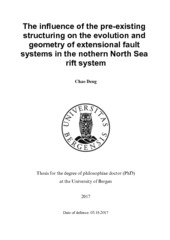| dc.contributor.author | Deng, Chao | |
| dc.date.accessioned | 2018-01-15T08:43:44Z | |
| dc.date.available | 2018-01-15T08:43:44Z | |
| dc.date.issued | 2017-10-03 | |
| dc.identifier.uri | https://hdl.handle.net/1956/17210 | |
| dc.description.abstract | The structural style and fault evolution in rift basins affected by pre-existing structuring differ considerably from those developing above the homogeneous crust, because pre-existing structures are likely to reactivate and influence the fault network during subsequent rift phase(s) and result in the development of non-collinear faults. Most recent studies on the development of non-collinear faults have focused on the two-dimensional or three-dimensional geometries and the evolution of the fault network, as well as on the debate of extension directions. However, little attention has been given to how pre-existing structures reactivate and grow in three dimensions during the subsequent rift phase, and how they influence the fault geometries and fault network in the proximity. The study contains two parts. The first part is the investigation of the geometry and evolution of normal fault systems of the Oseberg fault block in the northern North Sea which evolved over two separate rifting phases by interpreting seismic data (Paper I). The second part is the assessment of the fault growth pattern in three dimensions affected by a weak planar pre-existing structure during extension by discrete-element modeling (Papers II & III). Three- and two-dimensional seismic and well data have been used to identify fault network of the Oseberg fault block in the northern North Sea – a rift system that experienced the Permian – Early Triassic and Middle Jurassic – Early Cretaceous rifting and exhibits N-S, NW-SE and NE-SW oriented faults. The N-S- and NW-SEstriking faults initiated during the Permian – Early Triassic rifting, and most of them reactivated during the Middle Jurassic – Early Cretaceous rifting, with an E-W extension direction. In contrast, the NE-SW-striking faults are of Middle Jurassic – Early Cretaceous origin. Moreover, a population of NW-SE-striking faults formed during the inter-rift phase, indicating a NE-SW inter-rift extension direction. The study suggests a reorientation of the stress field from E-W during the Permian – Early Triassic rift phase to NE-SW during the inter-rift fault growth and back to E-W during the Middle Jurassic – Early Cretaceous rift phase in the Oseberg area. It also demonstrates that rift activity between established rift phases can locally develop faults with new orientations that add to the geometric and kinematic complexity of the final fault population. Discrete element modelling has been used to investigate fault geometry and evolution of fault network in three dimensions above a weak planar pre-existing structure with various orientations relative to the extension direction and dips. The likelihood of reactivation reduces with either the orientation relative to extension direction or the dip of the pre-existing structure. Fully reactivated structure becomes a major fault, which decreases the density, changes the orientation, and enhances the displacement of adjacent faults. In contrast, the partly or little reactivated structure provides favorable sites for the nucleation of new faults. The evolution of the pre-existing weak structure and fault network is divided into three stages: (i) reactivation of pre-existing structure and nucleation of new faults; (ii) radial propagation and interaction between reactivated structure and new faults; and (iii) linkage between reactivated structure and adjacent faults. The modelling results suggest that the reactivation pattern of a preexisting structure depends on both the orientation relative to extension direction and the dip, and influences the adjacent fault geometry and fault network via changing the fault density, length, orientation and displacement and providing favorable sites for fault nucleation. The research demonstrates the complexity of final fault network as a result of the different reactivation style of the pre-existing structure and its influence on new fault growth. The study also contributes to the understanding of the reactivation pattern of a pre-existing structure as well as the evolution and geometries of fault interactions in three dimensions between the reactivated structure and newly formed faults. Lastly, the thesis also throws light on the control of the orientation of a pre-existing structure on the likelihood of reactivation and its subsequent role on adjacent fault network. | en_US |
| dc.language.iso | eng | eng |
| dc.publisher | The University of Bergen | en_US |
| dc.relation.haspart | Paper I: Deng, C., Fossen, H., Gawthorpe, R. L., Rotevatn, A., Jackson, C. A., & Fazli Khani, H. (2017). Influence of fault reactivation during multiphase rifting: the Oseberg area, northern North Sea rift. Marine and Petroleum Geology, 86, 1252-1272. The article is available in the main thesis. The article is also available at: <a href="https://doi.org/10.1016/j.marpetgeo.2017.07.025" target="blank"> https://doi.org/10.1016/j.marpetgeo.2017.07.025</a> | en_US |
| dc.relation.haspart | Paper II: Deng, C., Gawthorpe, R.L., Fossen, H., & Finch, E. (2017). Influence of pre-existing weakness on normal fault growth during an oblique extension: a case study by discrete element modeling. The article is not available in BORA. | en_US |
| dc.relation.haspart | Paper III: Deng, C., Gawthorpe, R.L., Fossen, H., & Finch, E. (2017). How does the attitude of a pre-existing weakness influence fault development during renewed rifting? Some case studies by means of discrete element modeling. | en_US |
| dc.title | The influence of the pre-existing structuring on the evolution and geometry of extensional fault systems in the northern North Sea rift system | en_US |
| dc.type | Doctoral thesis | |
| dc.rights.holder | Copyright the author. All rights reserved | en_US |
| dc.identifier.cristin | 1501394 | |
